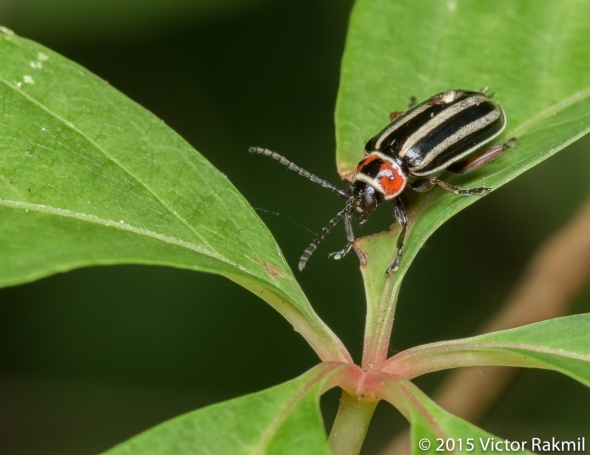An Unfortunate Beetle (Two Photographs) and a Few More Words on Macro
 To view more of my photography please click on www.rakmilphotography.com
To view more of my photography please click on www.rakmilphotography.com
This is one of the flea beetle family (Disonycha pensylvanica). Like all beetles its carapace divides to free its wings, and if you look closely you will see that one of the wings is damaged. I have not processed the more dramatic of the pictures where the injury is clear, as they are not photogenic. Flea beetles are tiny and in general are pests of most plant life. Some eat weeds and flea beetles have been introduced to take care of the problem. This was the first time I saw one of these beetles so I stuck with it for a while. I am always hoping to see something rare, but so far my collection of insect photography only includes common species. With respect to macro, the lighting here is artificial and you will note that the background is darker than the foreground. This is one aspect of light fall-off and if the greenery were only an inch further away, the background would have gone to black. In cases like this, opening the shadows in post-processing will bring back some but not all of the background and it will be noisy. There are solutions other people use for this, including two flashes, a piece of paper in the background etc. I can live with a black background once in a while if the foreground is interesting.


Victor, I would think that a darker background gives the foreground image more emphasis – thus being more appealing. I have judges who tell me that my background are too messy and distract from the flower/insect. Here is an example one image that received such comments. https://allentimphotos2.wordpress.com/2015/07/06/red-white-bee/ I’d welcome your thoughts on this issue and suggestions on changing the ways to shoot such images in the future. I don’t normally carry a flash but could do so.
LikeLike
March 28, 2016 at 1:34 pm
There is a reason I don’t enter contests. Clean backgrounds are hard. To get out of focus backgrounds you need to be closer to your subject than your subject is to the background. Assuming you took your picture at f2.8 moving closer would de focus the backgrounds, the same with any large aperture. As for the picture it’s great the background gives context. No need for flash. I often get great of four at 5.6, just depends on the formula above. N
LikeLike
March 28, 2016 at 1:46 pm
Victor, thank you. I’ll definitely, think about depth of field when doing such images. You’ll see on the image of the bee that it was shot at 1/125 sec at f/11.
Thanks again.
LikeLike
March 28, 2016 at 2:23 pm
My macro shots are all taken at 1/250 with fstops between f11-16. And I still get light fall off with a flash. What makes the difference is the ratio I wrote about. You could lower your fstop if the background is too close and the subject remains in focus. Another point is the size of the sensor, the smaller the sensor the more depth of field. So if you have 1.5 factor sensor you can multiply it by the focal length to get a field of view equivalent. E.g. 100 mm has a field of view that matches at 150 mm lens, now multiply the fstop by 1.5 and while it’s not perfect it does indicate that knowing the speed and fstop tells you very little without know the sensor. I can tell you I shot 2.8 because that is what my camera says but it’s closer to f4 in optical terms. Hope this helps.
LikeLike
March 28, 2016 at 3:13 pm
It does, thank you
LikeLike
March 28, 2016 at 3:32 pm
Beautiful shots, as always!
LikeLike
March 28, 2016 at 7:25 am
Thank you
LikeLiked by 1 person
March 28, 2016 at 7:30 am